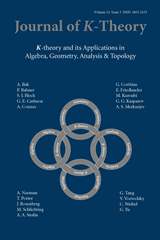No CrossRef data available.
Article contents
Grothendieck groups of complexes with null-homotopies
Published online by Cambridge University Press: 13 March 2014
Abstract
This paper uses differential-graded methods to give a streamlined proof of a theorem of Foxby-Halvorson. The theorem states that certain relative K-groups made from complexes with bounded (but arbitrarily long) length coincide with similar K-groups in which one sets an absolute bound on the length of the complexes.
- Type
- Research Article
- Information
- Copyright
- Copyright © ISOPP 2014




